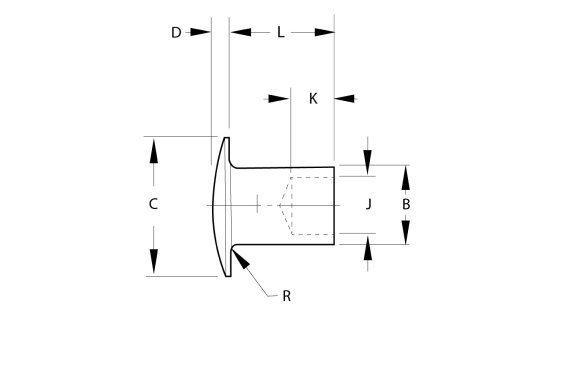PRAIRIE RIVET
Semi-Tubular Rivets
What are semi-tubular rivets used for? Common applications for semi-tubular rivets include light fixtures, HVAC ducts, electronics, ladders, and brakes, among many others. Semi-tubular rivets are also used to pierce and clinch malleable materials like leather, corrugated, plastic, rubber, or fabric where a pre-punched or drilled hole doesn’t exist.
How semi-tubular rivets work: Semi-tubular rivets have a shallow hole at the tip, opposite the head, which is why they are often referred to as hollow rivets. Tubular rivets work by rolling the tubular, or hollow, portion of the rivet outward by applying a force which causes the shank to roll or fold around the edge of the material or part the rivet is being applied to. Semi-tubular rivets reduce the amount of force needed for installation. In fact, semi-tubular rivets require roughly a quarter of the force of solid rivets for installation. This type of rivet can be fastened to a tight or loose fit depending on the application.
Semi-Tubular Rivets Head Styles
- Oval Head Rivets
- Truss Head Rivets
- Flat Head Rivets
Common Materials Used For Solid Rivets
- Steel
- Stainless Steel
- Aluminum
- Brass
- Copper
- Monel
Why Use Semi-Tubular Rivets?
- High-speed assembly
- Good joint strength
- Ease of joint inspection
- Easily adapted for automation
- Inexpensive alternative to threaded fasteners
- Little to no scrap is produced during the manufacturing process
- Can be used with a rivet cap to improve the appearance
- Tightly fasten joints together or use in hinged assemblies
- Fasten similar or different materials of multiple parts or pieces
- Air, hydraulic, or mechanical presses and hand clinch tools can also be used
- Can be used in impact rivet machines or in spin, orbital, or radial style rivet machines
- Force required to fasten is typically less than 40% of solid rivets so a less expensive assembly machine is required
- Pierce and clinch without a pre-drilled or punched hole in materials such as leather, corrugated, plastic, rubber, and fabric
Most Commonly Used Semi Tubualar Rivets
Wire Range: .084 to .242
Semi-Tubular Rivet Chart

| Prairie Rivet Part Number | Head Style | Body Diameter | Head Diameter | Head Thickness (+/-.005) | Hole Diameter | Hole Depth (+/-.005) | Max Length | Radius |
|---|---|---|---|---|---|---|---|---|
| A-1 | Oval | .084 - .089 | .144 - .150 | .023 | .064 | .064 | 1 | .010 |
| A-2 | Truss | .084 - .089 | .155 - .160 | 023 | .064 | .064 | 1 | .012 |
| B-1 | Truss | .094 - .099 | .182 - .192 | 029 | .071 | .071 | 1 | .012 |
| C-1 | Oval | .118 - .123 | .213 - .223 | .034 | .089 | .089 | 2 | .015 |
| C-4 | Truss | .118 - .123 | .229 - .239 | .042 | .106 | .106 | 2 | .020 |
| D-1 | Oval | .140 - .145 | .277 - .284 | .034 | .089 | .089 | 2 | .015 |
| D-3 | Truss | .140 - .145 | .307 - .317 | .042 | .106 | .106 | 2 | .020 |
| E-1 | Oval | .180 - .185 | .307 - .317 | .062 | .137 | .137 | 2 | .025 |
| E-3 | Truss | .180 - .185 | .370 - 380 | .062 | .137 | .137 | 2 | .025 |
| G-1 | Oval | .242 - .247 | .432 - .442 | .098 | .182 | .183 | 2 | .030 |
| G-2 | Truss | .242 - .247 | .495 - .505 | .098 | .182 | .183 | 2 | . 030 |
Ready To Start Your Next Rivet Order?
Order the semi-tubular rivets you need, request a quote, or contact us to talk with a member of our Prairie Rivet team to learn more. We will be happy to assist you.
